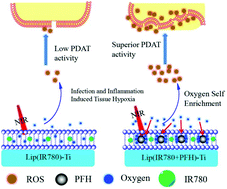Construction of perfluorohexane/IR780@liposome coating on Ti for rapid bacteria killing under permeable near infrared light†
Abstract
Near infrared (NIR) light induced photodynamic antibacterial therapy (PDAT) is a promising antibacterial technique in rapid in situ disinfection of bacterially infected artificial implants due to its penetration ability into tissues. However, the lower oxygen content in vivo may restrict the yields of reactive oxygen species (ROS), thus reducing the antibacterial efficacy of PADT significantly. Herein, liposome encapsulated photosensitizers (PS), IR780 and perfluorohexane (PFH), have been constructed on the surface of Ti implants via a covalent linkage to overcome this issue. Thanks to the high oxygen capacity of PFH, more ROS can be generated during NIR irradiation regardless of the low content of oxygen in vivo. As a result, in vitro tests demonstrated that 15 minutes of 808 nm near-infrared irradiation could achieve a high antibacterial efficacy of 99.62% and 99.63% on the implant surface against Escherichia coli and Staphylococcus aureus, respectively. By contrast, the PDAT system without PFH modification shows a lower antibacterial efficacy (only 66.54% and 48.04%, respectively). In addition, this enhanced PDAT system also possesses great biocompatibility based on the in vitro and in vivo subcutaneous assays. This surface system makes it possible for rapid bacteria-killing in artificial implants that have been implanted in vivo under local conditions with lower oxygen content.



 Please wait while we load your content...
Please wait while we load your content...